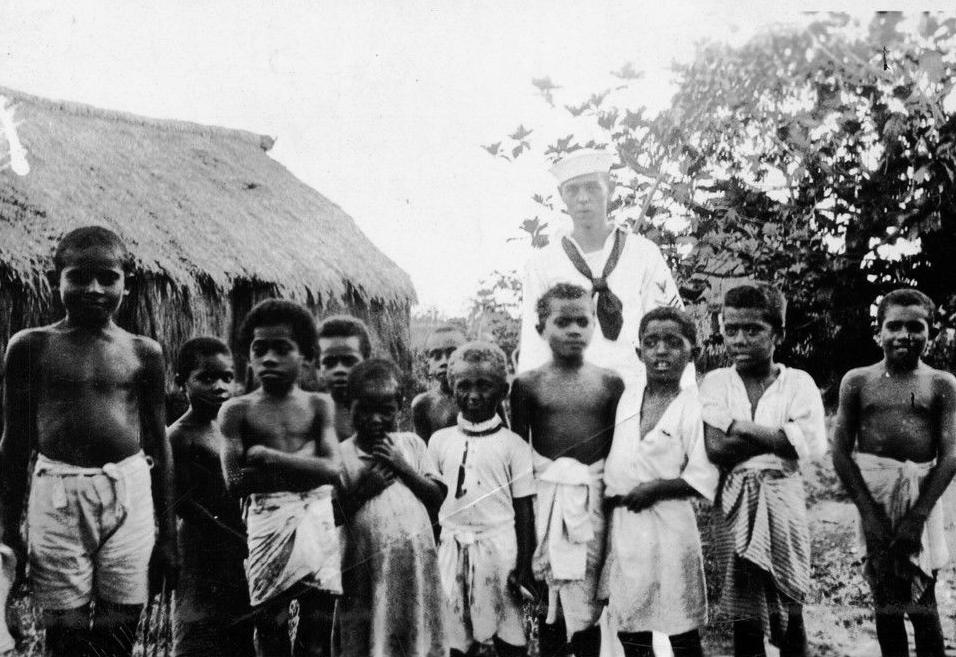
World War II South Pacific: Operation FS -- Precarious Allied Situation (January-June 1942)

Figure 1.-- The United States began its South Pacific buildup soon after Pearl Harbor (December 1942). The situation at the time the Japanese has schduled Operation FS was, however, still precarious on the targeted operations. American resources were still limited for which thre were many demands. New Caledonia, Fiji, and Samoa stood like a shield for the sea lances connecting Australia and New Zealand to America. Operation FS was to turn that shield into Japanese naval and air vases to sever the Australia's life line. As a result the United States began to amass forces on the islands. Here we see a scene on Fiji as a sailor got to know the Fijian people.
|
|
The United States began its South Pacific buildup soon after Pearl Harbor (December 1942). The situation at the time the Japanese has scheduled Operation FS was, however, still precarious on the targeted islands. American resources were still limited and there were countless demands. And the central American strategic vision agreed with the British was Germany First. The Australian Army was still largely in North Africa fighting the Afrika Korps with the British. General Tojo speaking in the Japanese Diet issued a final warning to Australia (May 28, 1942). One historian explains, "Japan was now tightening the noose on Australia." [Frei, p. 172.] Shortly after Japanese midget submarines staged an attack on Sydney Harbor (May 31). The American build up had only begun and at the time that Admoral Ymamoto sailed with almost the entire Imperial Fleet for Midway to oversee his MI brainchild , Operation FS was only one month awayand the balance of naval powerlay with the Japanese. After Pearl Harbor, the United states sought a forward training area and resupply base to serve as a potential line of defense against the Japanese sweep through the Pacific. A simple look at the map made in very clear where the Japanese Navy would strike--geography. Code breaking was not needed.
Fiji geographically and logistically was a key location. At the time the, Fiji was a British colony , but had only the Fiji Regiment supported by the New Zelanders. The United States rush the green 37th Army Division to Fiji, which was in place (June 1942).
The French on New Caledonia joined the Free French from a very early point, but there was no military force of any significnce on he island, omly the small Bataillon du Pacifique which was deployed to the Middle East like the Austrlian Army. The American Expeditionary Force landed in Noumea under the orders of General Pach (March 12). There were some difficult relations with the new governor, Admiral Thierry d'Argenlieu. New Caledonia as a highly effective unsinkable but immobile aircraft carrier against the Japanese, notably during the Battle of the Coral Sea (May 1942) and the intense naval battles around Guadalcanal (August-November 1942).
Shortly after Pearl Harbor a U.S. Marine Brigade arrived with 5,600 officers and enlisted men with their heavy artillery to defend Samoa (January 20, 1942). Samoans were recruited to form the Samoan Marine Brigade (Maligi Samoa) consisting of 350 men. Tutuila island would become the most important jungle training center in the South Pacific.
The Americans had rushed aircraft to these islands, if the First Air Fleet had not been destoyed at Midway, further aircrafy and supplies would have been cut off. With the sea lanes cut, the only source of replacement aircraft and supplies would have been Australia and the Australians woukd have need what they had for the air battles with the Japanese. What happened on Midway during the morning of June 4 is a template for what could have happned on these islands.
Sources
Frei, Henry. Japan's Southward Advance and Australia.
CIH -- WW II

Navigate the CIH World War II Section:
[Return to Main Japanese Operation FS page]
[Return to Main World War II Battle of the Coral Sea page]
[Return to Main World War II South Pacific naval campaign page]
[Return to Main World War II naval campaign page]
[Return to Main World War II page]
[About Us]
[Biographies]
[Campaigns]
[Children]
[Countries]
[Deciding factors]
[Diplomacy]
[Geo-political crisis]
[Economics]
[Home front]
[Intelligence]
[POWs]
[Resistance]
[Race]
[Refugees]
[Technology]
[Totalitarian powers]
[Bibliographies]
[Contributions]
[FAQs]
[Images]
[Links]
[Registration]
[Tools]
[Return to Main World War II page]
[Return to Main war essay page]
[Return to CIH Home page]
Created: 1:54 PM 12/28/2017
Last updated: 1:54 PM 12/28/2017



